By: John Landrigan [ka4rxp@gmail.com]
Plans continue to make certain that all is in readiness for my expeditionary cruise to Antarctica aboard the M/V Enderby in February 2018.
A cruise previously planned to Australia and New Zealand aboard the Holland American Line ‘”Noordam” occurred in late October. 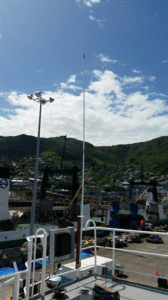 During that time I was able to visit with Rodney, the owner of Heritage Expeditions in Christchurch, New Zealand and Rowan Homes who owns Nautic Electronics.
During that time I was able to visit with Rodney, the owner of Heritage Expeditions in Christchurch, New Zealand and Rowan Homes who owns Nautic Electronics.
I gave Rowan the MFJ 998RT auto-tuner and he installed it inside of a Fiberglass Reinforced General Purpose enclosure. This and the Pacific Aerials High Frequency SSB Vertical were then mounted on a top deck railing aboard the Enderby.
(Left) Antenna and MFJ Auto-Tuner on top deck of M/V Enderby.
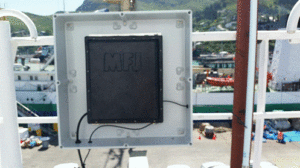
MFJ 998RT inside reinforced fiberglass enclosure (Right)
Another project was to be assured the primary radio set up – the Yaesu FT 897 and SPE 1.3KW amplifier were communicating happily with each other and the MFJ 998RT auto-tuner. This necessitated a ‘road trip’ to Starkville, Mississippi, home of MFJ where Martin Jue, Richard Stubbs, Ben, Mike and others let me set up a temporary station using a vertical antenna and testing everything out. All worked well.
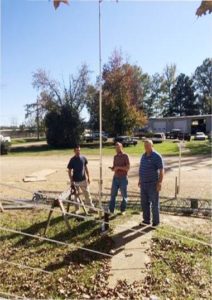
MFJ employees setting up temporary vertical so functional testing of the Yaesu 897, SPE 1.3KW amplifier and MFJ 998RT auto-tuner could be verified. (see pic to the Right)
Bolted onto an aluminum panel with padding underneath are the Yaesu FT-897 and SPE 1.3KW amplier. The amplifier can fly as in-cabin, carry on luggage due to its compact size and 22 pounds weight. The SCS Pactor Modem and West Mountain Radio RigBlaster Blue sit on top of the white Velcro mounting patches.
My visit with Rodney was most enjoyable and informative. This voyage is one that I feel especially fortunate to be going on. I’ll provide more details via the radio email Winlink program during the trip.
If propagation is more favorable in February than it was in October, I should be able to make a large number of contacts especially during Antarctica Activity Week, February 17 to 25, 2018.
As a back up, I will be using an Icom 7100. A problem shared by both the FT 897 and the IC 7100 is a lack of sockets to plug stuff into. Common to both radios is the need to have an SCS PACTOR Modem as part of the complement, and, to have minimal to none cable switching going on.
(Below:) Equipments: Yaesu FT-897 and SPE 1.3KW amplifier
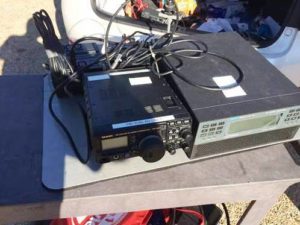 The FT 897 problem was resolved with a bhi CAT-MATE Electronic “Y” Splitter and a quick jumper move at J102 on the ACC 1/8 inch socket for ALC and PTT control to the SPE amplifier.
The FT 897 problem was resolved with a bhi CAT-MATE Electronic “Y” Splitter and a quick jumper move at J102 on the ACC 1/8 inch socket for ALC and PTT control to the SPE amplifier.
The Icom 7100 requires the use of the ACC conversion cable (OPC-599). ACC1 on the “Y” cable accepts a 9090 cable from Farallon Electronics to the SCS PACTOR Modem. The ACC2 socket will take the PNP-7D1 cable to the MFJ Ameritron ARB-704 amplifier-to-transceiver interface. The ARB-704 will output ALC and PTT to the SPE amplifier.
Of course another road trip to Starkville will be necessary to make sure all this works.
Next on the list is an after Christmas shopping trip to the Mall of America in Minneapolis, Minnesota for warm weather gear as per the suggestions of Heritage Expeditions and several other ham friends.
All I want for Christmas is an SFI above 100 for the month of February. I won’t be too dismayed if there is a good to spectacular auroral display sometime before we get to midnight sun conditions.
TNX and credit: John Landrigan KA4RXP
What else to say? John, congrats for the excellent job. You and your friends are doing really great.
All seems to be well planned, and your Antarctic adventure, I’m sure, will give you lots of satisfactions; we’ll follow you every day.
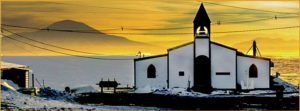 The Chapel of the Snows, a non-denominational place of worship at NSF’s McMurdo Station, Antarctica, overlooks McMurdo Sound and the Royal Society mountain range.
The Chapel of the Snows, a non-denominational place of worship at NSF’s McMurdo Station, Antarctica, overlooks McMurdo Sound and the Royal Society mountain range.

 The new base will be a 5,000-sq-m structure that can accommodate 64 people and 18 laboratories. As well as the living and working quarters, the company will build a heliport, solar panels and wind turbines that will power the base.
The new base will be a 5,000-sq-m structure that can accommodate 64 people and 18 laboratories. As well as the living and working quarters, the company will build a heliport, solar panels and wind turbines that will power the base. During that time I was able to visit with Rodney, the owner of Heritage Expeditions in Christchurch, New Zealand and Rowan Homes who owns Nautic Electronics.
During that time I was able to visit with Rodney, the owner of Heritage Expeditions in Christchurch, New Zealand and Rowan Homes who owns Nautic Electronics.

 The FT 897 problem was resolved with a bhi CAT-MATE Electronic “Y” Splitter and a quick jumper move at J102 on the ACC 1/8 inch socket for ALC and PTT control to the SPE amplifier.
The FT 897 problem was resolved with a bhi CAT-MATE Electronic “Y” Splitter and a quick jumper move at J102 on the ACC 1/8 inch socket for ALC and PTT control to the SPE amplifier.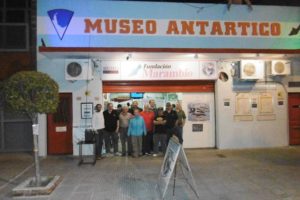 Following the Nov. 4th activation of the Antarctic Museum Marambio by the Radio CLUB QRM Belgrano hereby some datas coming from Raul Bobn Foster LU5AR, Secretary of the RC:- Se ha completado la información en la página de la actividad. Toda la información en general y el log en particular, está listo. Se hicieron más de 300 QSOs-.
Following the Nov. 4th activation of the Antarctic Museum Marambio by the Radio CLUB QRM Belgrano hereby some datas coming from Raul Bobn Foster LU5AR, Secretary of the RC:- Se ha completado la información en la página de la actividad. Toda la información en general y el log en particular, está listo. Se hicieron más de 300 QSOs-.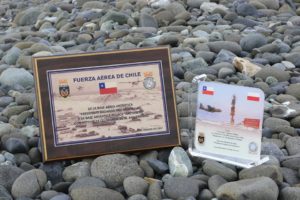 Now that the Antarctic Campaign 2017-2018 is almost open, it’s time to make presentations and get to know the neighbors.
Now that the Antarctic Campaign 2017-2018 is almost open, it’s time to make presentations and get to know the neighbors.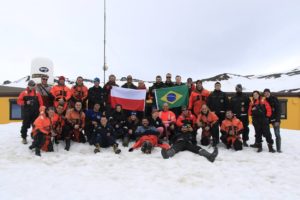
 Just to inform the readers, Antarctic lovers and followers that, it’s time to meditate about the 15th Antarctic Activity Week which will be on air from 17 through 25 Febr. 2018.
Just to inform the readers, Antarctic lovers and followers that, it’s time to meditate about the 15th Antarctic Activity Week which will be on air from 17 through 25 Febr. 2018.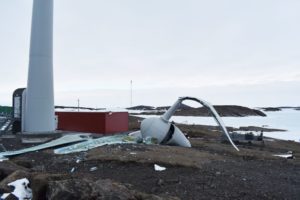 Part of a wind turbine at Australia’s Mawson research station (WAP AUS-Ø4) in Antarctica has collapsed overnight, no one was injured in the incident. The head of the turbine fell to the ground about 9 pm Mawson Station time last night.
Part of a wind turbine at Australia’s Mawson research station (WAP AUS-Ø4) in Antarctica has collapsed overnight, no one was injured in the incident. The head of the turbine fell to the ground about 9 pm Mawson Station time last night.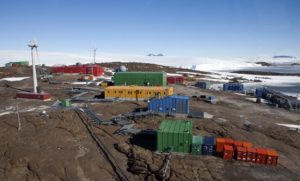 investigated.”
investigated.”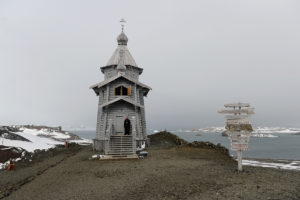 Members of the Antarctic Uruguayan ARTIGAS Base (WAP URY-Ø1), journalists and other guests visited the Trinity Church in Russia’s Bellinsghausen Polar Station (WAP RUS-Ø1) on King George Island, Antarctica, during the first week of December 2015. The priest explained to guest how the church was built as well as delivered a speech about the Orthodox and Christian churches in the twenty-first century. (see a video by cicking the gif aside)
Members of the Antarctic Uruguayan ARTIGAS Base (WAP URY-Ø1), journalists and other guests visited the Trinity Church in Russia’s Bellinsghausen Polar Station (WAP RUS-Ø1) on King George Island, Antarctica, during the first week of December 2015. The priest explained to guest how the church was built as well as delivered a speech about the Orthodox and Christian churches in the twenty-first century. (see a video by cicking the gif aside) 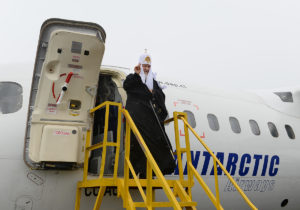
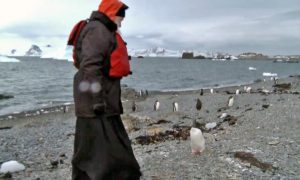
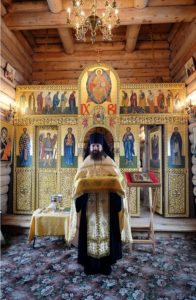

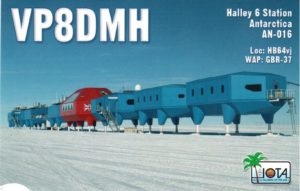 British Antarctic research station to shut for second winter as cracks in ice grow
British Antarctic research station to shut for second winter as cracks in ice grow  Novolazarevskaya Station is located at the extreme southeastern tip of the Schirmacher Oasis approximately in 80 km from the Lazarev Sea coast. An ice shelf with a slightly undulating surface resting against an ice cap extends north of the Station in the vicinity of Leningradsky Bay. From the south, there is a continental ice sheet slope. The station was opened on January 18, 1961. First constructions included service space, a living house, a mess-room and a power station, as well as glaciological, magnetic and actinometric pavilions and auxiliary space. There is a runway (1200 m x 60 m dimensions and the landing course of 114°) in the station area for ski- and wheeled aircraft located in 15 km south of the station on the ice sheet surface at the 500 m elevation above sea level.
Novolazarevskaya Station is located at the extreme southeastern tip of the Schirmacher Oasis approximately in 80 km from the Lazarev Sea coast. An ice shelf with a slightly undulating surface resting against an ice cap extends north of the Station in the vicinity of Leningradsky Bay. From the south, there is a continental ice sheet slope. The station was opened on January 18, 1961. First constructions included service space, a living house, a mess-room and a power station, as well as glaciological, magnetic and actinometric pavilions and auxiliary space. There is a runway (1200 m x 60 m dimensions and the landing course of 114°) in the station area for ski- and wheeled aircraft located in 15 km south of the station on the ice sheet surface at the 500 m elevation above sea level. If you check QRZ.com you will notice that R1ANL is reported to be a call being active from Leningradskaya Base; a good explanation is kindly given by Dominik Weiel DL5EBE (aka R3/DL5EBE).
If you check QRZ.com you will notice that R1ANL is reported to be a call being active from Leningradskaya Base; a good explanation is kindly given by Dominik Weiel DL5EBE (aka R3/DL5EBE). and I offered him to take care about the R1ANL QSL cards. A few months later I received the original handwritten R1ANL logs. I manually entered all QSOs into my computer and created ADIF files which I uploaded to LoTW, ClubLog and I also printed paper cards which are available via DL5EBE (buro and direct)-.
and I offered him to take care about the R1ANL QSL cards. A few months later I received the original handwritten R1ANL logs. I manually entered all QSOs into my computer and created ADIF files which I uploaded to LoTW, ClubLog and I also printed paper cards which are available via DL5EBE (buro and direct)-.